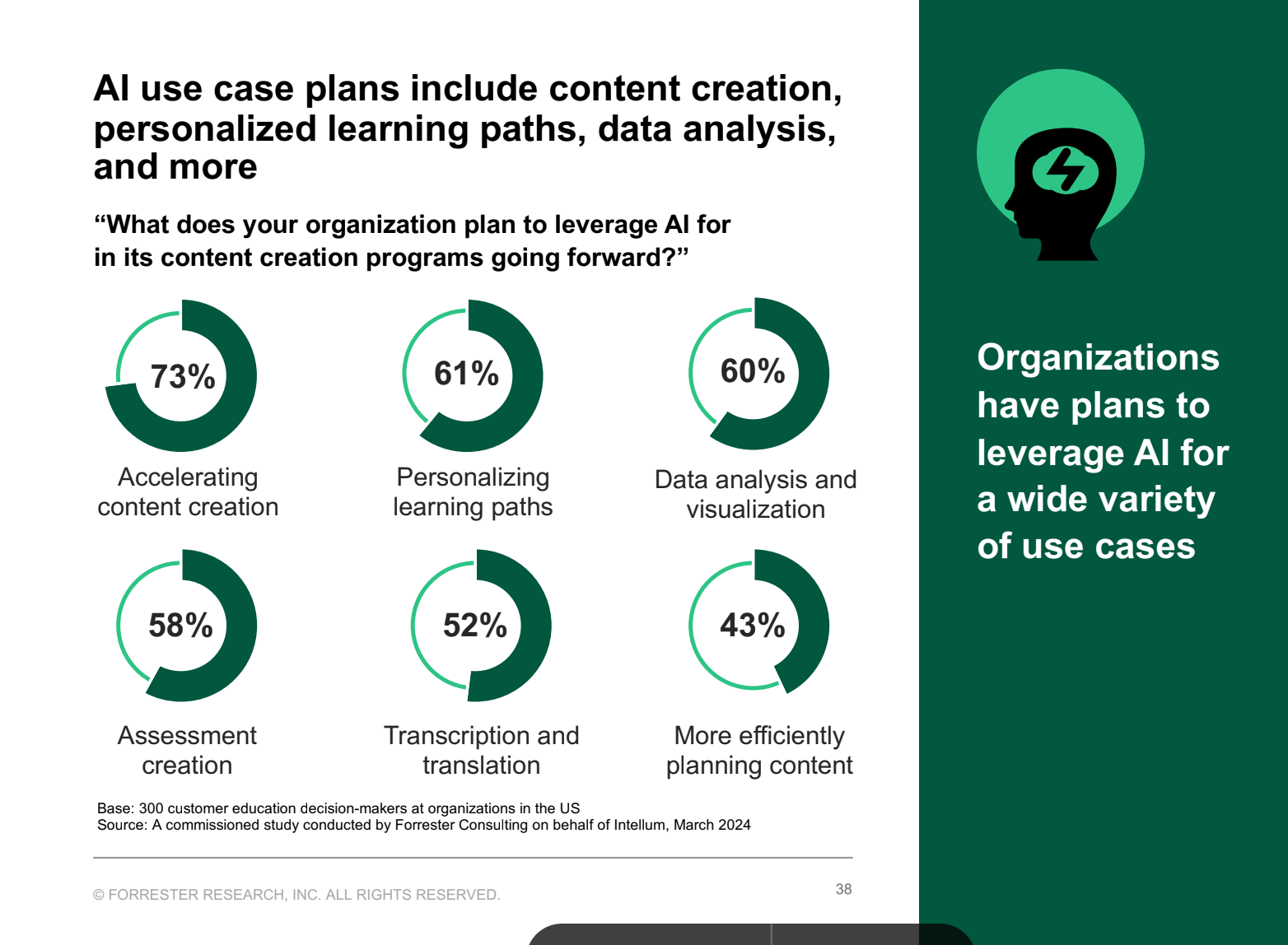It’s official: Artificial intelligence (AI) has taken the world by storm. As data centers grow larger and more powerful by the day, they’re giving rise to next-generation AI models—and next-level disruption. From AI content generation to chatbots and meeting summaries, the way we do business is forever changing.
As a learning and development expert, it can be hard to make heads or tails of it all. AI brings a lot of potential power—but also plenty of skepticism. Education is such a unique personal journey. With AI, don’t we risk losing the “person” element altogether?
The answer might surprise you. L&D teams are already embracing AI content creation for training, and the early results are promising. In this article, we’ll explain how AI is transforming course authoring software, and share how education platforms like Intellum are leveraging AI to help L&D teams deliver high-quality learning experiences in a fraction of the time.
Why is AI content creation for training important?
Instructional design is a delicate art. Whether you’re building a new product certification, training resellers on a key feature, or upskilling and reskilling employees for the future, success hinges on your ability to engage the learner, no matter where they’re at. By designing personalized learning experiences, you ensure a steady hand to guide anyone toward their learning goal.
AI content development only further helps to enable that goal. With the right AI tools, instructional designers can accelerate the time to outline, storyboard, and publish eLearning content—freeing up opportunities to polish and personalize that content to the needs of their audience.
“It’s completely changed our authoring process,” said Doug Pietrzak, Founder of FreshCognate and former L&D lead at Google. “We often start by compiling documents and working with AI to build a structure, learning objectives, and other elements. We work together with AI to build a good 60% to 80% of the course, and then we refine afterward.”
Pietrzak’s team is far from an outlier. In our 2024 Customer Education Benchmarks & Trends Report conducted by Forrester, 300 education leaders shared how their organization plans to use AI content creation for training in the future. A staggering 73% said that AI will accelerate the speed at which their teams create content.

What are the risks of AI content creation for training?
There’s no question that AI can significantly speed up content creation. But that’s only one piece of the puzzle. If you can’t create high-quality course content to match that pace, then your AI-powered efforts are dead on arrival. It’s important, then, to understand the strengths—and current limitations—of AI in education technology.
“AI is really great at creating learning objectives, writing in a consistent tonal voice, and writing assessments,” explained Pietrzak. “In those areas, it's been particularly beneficial and often can outperform humans.”
A common fear with AI is that it seems designed specifically to replace human interaction. While that’s certainly an understandable concern—economists at Goldman Sachs predict a global displacement rate upward of 14% due to AI—the reality is that we’re still far from an AI-driven future. Computations are far from instantaneous, AI analysis can quickly go haywire with the wrong prompt, and AI video generators still haven’t escaped the uncanny valley effect.
In a field as specialized as learning and development, the work you produce is as important as ever. AI isn’t going to change that. If anything, AI is best positioned as a tool to handle the most time-consuming and repetitive tasks your L&D team faces. Whether you’re summarizing key takeaways for a quiz, standardizing copy to fit brand guidelines, or auditing content to identify learning gaps, view AI as an accelerator in the content creation process.
Ultimately, however, the fine-tuning is always up to you.
“AI isn’t bad at a first draft of content, but often needs quite a bit of work,” said Pietrzak. “We have yet to see AI do a good job of choosing learning components to use to display specific information, and these teaching elements are still where we rely heavily on humans.”
Tips for using AI-powered eLearning tools responsibly
As an instructional designer or facilitator, you put so much time and effort into the learning experience. No matter your audience—clients, employees, or channel partners—it’s important that each person feels confident in your program and supported in their individual learning journey. If you’re using AI, you don’t want to compromise quality for speed.
That’s where the right AI tools come into play. When leveraging AI content creation for training, here are three tips to ensure you use AI responsibly.
1. Know what great looks like.
We said it earlier, and we’ll say it again: AI can’t replace L&D. You’ve dedicated your craft to designing courses and trainings that speak to the humans in the room (or online). AI can help you move faster, but human intervention and oversight will always be necessary.
To use AI effectively, it’s important to know when to guide your model, and how. This starts with an airtight understanding of the fundamentals, from your company’s style guide and accessibility best practices to the exact learner personas you’re looking to reach.
“It's helpful for L&D professionals to know what excellent course design and writing looks like, so that they can effectively check AI work closely and refine it,” said Pietrzak.
2. Revise and polish.
AI can provide you with a solid starting point, but the magic happens afterward. Once you’ve identified a set of learning goals and authored your course, it’s time to stress-test. Ask yourself the following:
- Have I tested this course from end to end?
- Is the copy clear, engaging, and—above all else—useful?
- Are there gaps in the content that need to be addressed?
- Have we employed a mix of multimedia?
- Is our content personalized to the end user?
- Is our eLearning accessible to all potential users?
That’s just a shortlist; be sure to loop in relevant stakeholders to ensure you’re gathering and tackling the right feedback. AI models can help check for certain gaps as you design, but the more granular your learning paths become, the more human intervention you’ll likely need.
“AI can do a good first pass on bias, but less so on accuracy and not as much on learner engagement,” Pietrzak explained. “All courses created need the last several rounds of work to be done mostly by humans to really hone in on these aspects, not to mention many more around voice, pacing, and depth.”
3. Embrace AI for video content creation.
Video has become a cornerstone of effective eLearning—but traditional video production often requires long lead times, high costs, and heavy reliance on subject matter experts. From coordinating on-screen talent to managing edits and updates, keeping videos current can be a challenge. AI video content creation tools offer a faster, more flexible way forward.
Platforms like HeyGen and Synthesia allow you to create realistic AI avatars that can stand in for subject matter experts, eliminating the need to put busy SMEs on camera. On the other hand, tools like Clueso and Videate streamline the video creation process itself—making it possible to produce and update content in real time. This is particularly valuable in industries where product interfaces or workflows change frequently, since video editing and updates no longer require full re-shoots.
By combining these AI-powered approaches, L&D teams can maintain high-quality training videos without the typical bottlenecks. You’ll still want human oversight to shape messaging and ensure learner engagement, but AI takes the pain out of repetitive production tasks. The result: engaging, up-to-date content that adapts quickly to change while freeing your team to focus on creating meaningful learning experiences.
4. Pick the right tool.
As you find that sweet spot between AI use and human touch, you’ll find that the quality of your AI tools (and models) goes a long way. OpenAI, Copilot, and Gemini have dominated the broader conversation, but plenty of AI content creation tools offer alternative Natural Language Processing (NLP) models that may be a better fit for your training needs.
“It's great to try out new AI tools as they come into the market and continually evaluate which one offers the best writing, or the best design,” said Pietrzak. “The tools are constantly changing.”
The best tool for your needs is subjective; it depends on your business needs, as well as your L&D needs. That said, make sure you’re prioritizing AI tools that make your life easier, not harder. Look for a suite with powerful authoring tools, useful automations, and intentionally crafted AI workflows that allow for plenty of human strategy and guidance.
Did you know? Consulting giant Accenture recently used Intellum’s native AI tools to enhance its existing education training. Using our Generative Assessment feature, Accenture created assessment questions with an accuracy rate of 80%, saving 270 hours of hands-on work.

Turn AI from adversary to ally with Intellum.
At Intellum, we get that L&D is a forever-human art. Our education platform is built with your team in mind, with AI tools that actually help you get work done faster and more reliably.
Our content authoring tool, Evolve, gives L&D leaders the tools to build beautiful courses from scratch. After you build, use our AI Creator to automate the tedious aspects of course design. Create relevant learning objectives in seconds. Create high-quality assessments with our Generative Assessments tool. You can even stress-test learning paths—and identify potential learning gaps—by chatting with our AI Assistant.
With Intellum, you’re always in the driver’s seat. AI is simply here to help.



.png)

